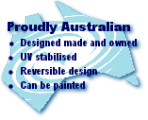What's in a filter?
Inline filters produced by a number of manufacturers are similar in performance but AQUATREK recommends the HOLMAN product for the following reasons:
- The internal filter cartridge is made from a tough but flexible white plastic that clearly shows any trapped sediment. Many other filters are black and have proven difficult to judge where cleaning is best concentrated.
- The HOLMAN filter is available in three end sizes, 13mm, 19mm and 25mm.
- Both ends are removable and size interchangeable, allowing the filter to join different size hoses.
- The convenience and advantage of clever design is obvious.
Most filter cartridges have mesh aperture sizes ranging from 80mm to 175mm. Manufacturers unfortunately rarely indicate the filter mesh size. A choice and indication of size would be an advantage to consumers.
While suitable for use with mains water, INLINE FILTERS ARE NOT SUITABLE FOR USE WITH RAINWATER HARVESTING SYSTEMS as the internal filter cartridge presents a physical barrier which reduces velocity and the more contaminants it traps, the more restricted it becomes.
LOW COST DIY FILTER SEDIMENT TRAP
It is easy to make a simple inline filter that can extract about 60% of the remaining finer debris passing from the Supadiverta to a tank. It is also good for gardeners feeding to gravity fed drip hoses. Unlike a commercial inline filter it will not present a physical barrier which reduces velocity as it traps contaminants.
When fitted to a horizontal pipe it will remove a large percentage of the bed load.Bed load travels slowly along a straight length of pipe. By fitting an inverted tee to a straight non turbulent section of pipe and connecting the tee to an elbow, a lot of sediment will fall down the tee. Larger tee branches are more effective.
There are several combinations of fittings that can be used after the bush.
Water harvested to tanks will be much cleaner and the fitting is also popular with pool owners.
PHOTO 13: DIY sediment trap. (One version).

Fit a plain tee (branch facing downwards) to the horizontal pipe.
Fit two 45 degree or a 90 degree elbow as shown and reduce the elbow outlet with a bush.
Connect the bush to a faucet socket and a director as depicted.
Connect a 19mm or 25mm poly pipe and fit an inline tap to the end.
The smaller poly pipe will flush the captured sediment at high velocity when the tap is opened.
Fit two 45 degree or a 90 degree elbow as shown and reduce the elbow outlet with a bush.
Connect the bush to a faucet socket and a director as depicted.
Connect a 19mm or 25mm poly pipe and fit an inline tap to the end.
The smaller poly pipe will flush the captured sediment at high velocity when the tap is opened.
PHOTO 14: Very compact when fitted.

The poly pipe can be any length. This simple trap works well and the pipe will not block because water has already passed through the Supadiverta 750 micron filter and discharges at a high flow rate.
OF INTEREST:
Water flowing through a pipe travels faster through the core and slower on the outside extremity due to wall induced friction loss.
Water flowing through a pipe travels faster through the core and slower on the outside extremity due to wall induced friction loss.
Over 90% of the debris travels slowly along the bed load provided the flow is not turbulent. The inverted tee will capture much of this bed load.






